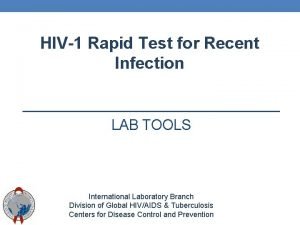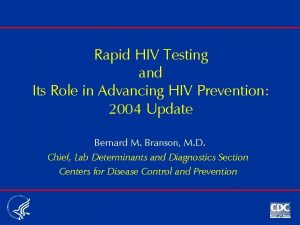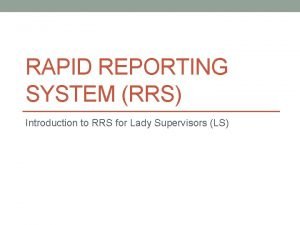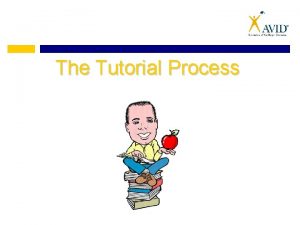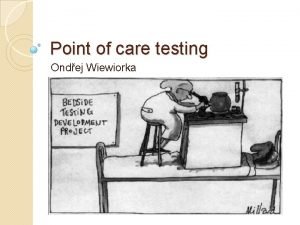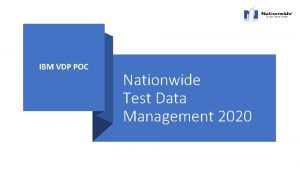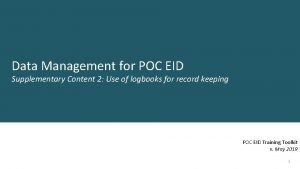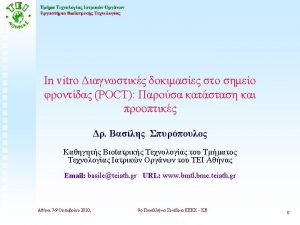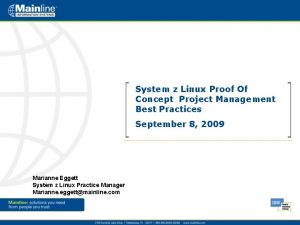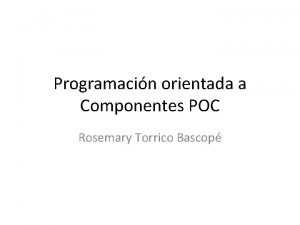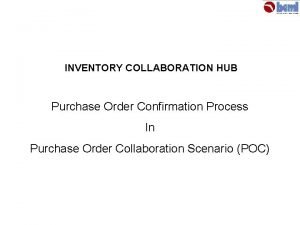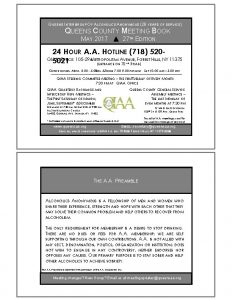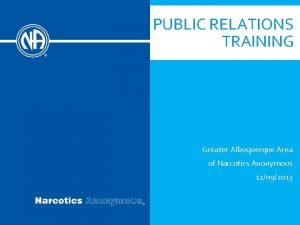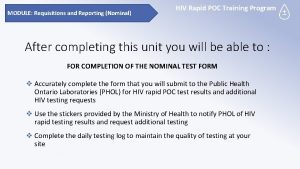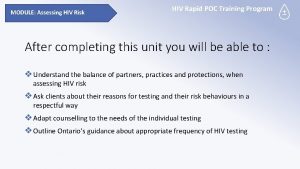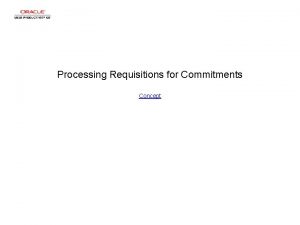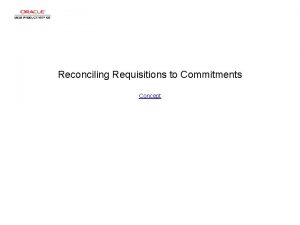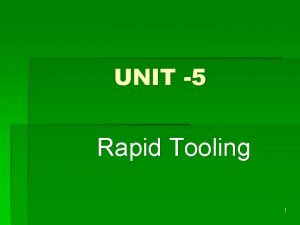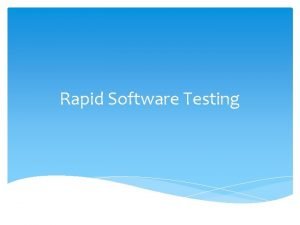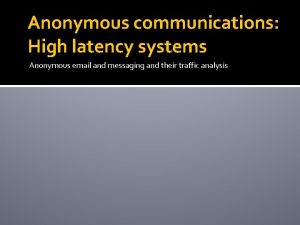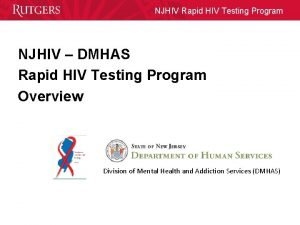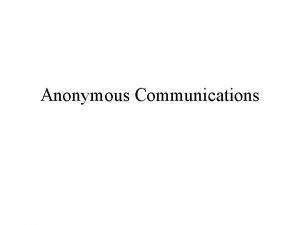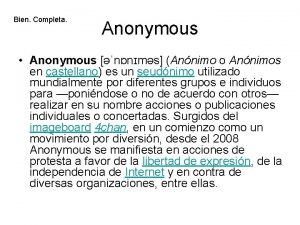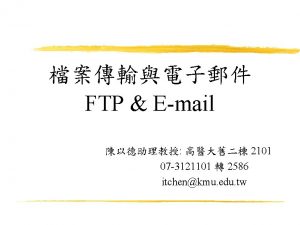MODULE Requisitions and Reporting Anonymous HIV Rapid POC























- Slides: 23

MODULE: Requisitions and Reporting (Anonymous) HIV Rapid POC Training Program After completing this unit you will be able to: FOR COMPLETION OF THE ANONYMOUS TEST FORM v Accurately complete the form that you will submit to the Public Health Ontario Laboratories (PHOL) for HIV rapid POC test results and additional HIV testing requests v Use the stickers provided by the Ministry of Health to notify PHOL of HIV rapid testing results and request additional testing v Complete the daily testing log to maintain the quality of testing at your site v Use the logs to find the results of a client who has misplaced their tracking number

MODULE: Requisitions and Reporting (Anonymous) HIV Rapid POC Training Program Record Keeping is Essential Every time you do a POC HIV test for a client, you MUST: v Complete an Anonymous HIV Serology Requisition form v Make a log entry for the test on your site’s daily log v Create a take-home card for the client with their anonymous identification number These record-keeping steps are essential to provide accurate results for your clients and to maintain quality standards at your testing site. Errors in this record keeping would be an incident that requires an investigation at your site. Effective record-keeping is necessary to maintain approval for testing at your site.

MODULE: Requisitions and Reporting (Anonymous) HIV Rapid POC Training Program Anonymous HIV Serology Requisition This form is used ONLY BY DESIGNATED ANONYMOUS TEST SITES. This is the only form that should be used when the client is requesting anonymous testing including: • Rapid POC testing done at your site • Laboratory testing from the Public Health Ontario Laboratory (PHOL) Whenever you do a valid POC test, you must submit a form to PHOL. Be sure to complete the form and all of its fields in full. You only submit ONE form for each client, even if you are reporting a POC test result and requesting a follow-up test for confirmation or further window period screening.

MODULE: Requisitions and Reporting (Anonymous) HIV Rapid POC Training Program Anonymous HIV Serology Requisition v Your clinic will most often have pre-printed forms with this portion complete. v If you need to complete it by hand, the doctor’s name is the person who holds your site’s medical directive and their CPSO# is used. Where do you get forms when you need them (or more when you run out)? Ask about the practice at your site.

MODULE: Requisitions and Reporting (Anonymous) HIV Rapid POC Training Program Labelling and Anonymous Requisitions When using this form, the large numbers at the bottom are an important part of the process. They maintain the client’s anonymity while ensuring the client gets accurate results: Remove the peel-off sticker numbers. Use: • One to label the blood sample (if submitting) • One to label the POC testing membrane (if doing a POC test) • One on the client’s take home card The number of the blood sample and the requisition must match or the lab will not process the specimen. Both the form and the sample must also have the date you collected this sample. A client record folder should also be created using this number, and stored separately from any other records this client may have.

MODULE: Requisitions and Reporting (Anonymous) HIV Rapid POC Training Program Required Fields Relatively little patient information needs to be included in the patient information section: • Client’s year of birth (no month or day) • Client’s sex Ask the client if they have an anonymous testing code from a previous testing experience at your clinic. If so, it is helpful to add this number to the record, so your site and the Ministry can better understand, whether or not clients are testing routinely.

HIV Rapid POC Training Program MODULE: Requisitions and Reporting (Anonymous) Required Fields Most tests will be routine – although you may identify additional reasons for testing, such as sexual assault or symptoms of acute HIV infection, when speaking with the client. Complete this section based on your site’s records of this client OR what the client tells you about their history. This information is often collected on your site’s intake form. x

MODULE: Requisitions and Reporting (Anonymous) Required Fields Collected during your risk assessment of the client All required sections of the form are important for provincial planners to understand where more HIV prevention and care services are needed. They are not used to “track” individual patients. HIV Rapid POC Training Program

MODULE: Requisitions and Reporting (Anonymous) HIV Rapid POC Training Program When Submitting a Sample When doing follow-up standard testing on a POC test, or when submitting standard testing early in the window period, complete the specimen details: • Make sure you add the date of the test • You will usually be submitting serum (red top tube) and requesting an HIV 1/HIV 2 test. Make sure the client has their take home card with the peel-off ID number attached. This is how you will identify their results when they return. X X

MODULE: Requisitions and Reporting (Anonymous) HIV Rapid POC Training Program Lost ID Numbers If an ID number is lost: v Encourage the client to return for their results, even if they lose their card and number. v You can use the daily log on the day they came in and look up anonymous files listed to see if the information and risk factors match the client. v Clients concerned about losing their number can give you a code word to add to this anonymous file, so that when you look it up you know you have found the correct file!

MODULE: Requisitions and Reporting (Anonymous) HIV Rapid POC Training Program Testing Scenarios Here are some scenarios you will encounter when testing clients: 1) Your client requests standard testing (You did not do a rapid test. ) 2) You perform a rapid POC test and it is non-reactive and outside the window period. 3) You perform a rapid POC test and it is non-reactive. However, the client is from a priority population, and has had a very recent high risk exposure (either in the last 2 -4 weeks or with current signs of acute HIV infection). 4) You perform a rapid POC test and it is reactive. 5) Your client has two invalid POC tests, and you are submitting a sample for testing.

MODULE: Requisitions and Reporting (Anonymous) HIV Rapid POC Training Program 1) Standard Testing Some of your clients will choose to have a standard HIV test instead of a rapid test. After counselling and consent: v Draw and label a tube of blood (red top tube) v Complete the form fully v Ensure that the ID code and date on the sample matches the ID code and date on the form (two matching identifiers are required on the sample and form) No Sticker necessary v Submit the tube and requisition; enter the record of this test on the daily log. Book an appointment in approximately one week for the client to return for their result.

MODULE: Requisitions and Reporting (Anonymous) HIV Rapid POC Training Program 2) A Non-reactive POC Test After counselling and consent: v You perform a POC test; it is non-reactive and the client is not in the window period v Complete the form fully; attach a GREEN non-reactive sticker v Submit the requisition; enter the record of this test on the daily log v Complete post-test counselling with the client. Advise client about further testing (follow-up on a high risk exposure or routine testing. ) NOTE: PHOL report will be issued for this submission, it can be discarded. X

MODULE: Requisitions and Reporting (Anonymous) HIV Rapid POC Training Program 3) A Non-Reactive Window Period Test After counselling and consent, you determine that: The client is from a priority population and has had a very recent high risk exposure (in the last 2 -4 weeks or with signs of acute HIV infection). v Perform a POC test; it is non-reactive. v Recommend the client submit a standard test for p 24 testing; if the client agrees, draw blood. v Complete the form fully; attach a YELLOW “non-reactive window period” sticker. Ensure that the ID#/date on the sample matches the ID#/date on the form. v Submit the requisition; enter the test on the daily log. Complete post-test counselling. Book an appointment in one week to share results.

MODULE: Requisitions and Reporting (Anonymous) HIV Rapid POC Training Program 4) A Reactive POC Test After counselling and consent, you: v Perform a POC test; it is reactive v Recommend client submit a standard test to confirm this result; if the client agrees, draw blood v Complete the form fully; attach a PINK reactive sticker. Ensure that the ID#/date on the sample matches the ID#/date on the form. v Submit the requisition; enter test on the daily log. Complete post-test counselling. Book an appointment in one week to confirm result.

MODULE: Requisitions and Reporting (Anonymous) HIV Rapid POC Training Program 5) Two repeated Invalid tests After counselling and consent: v Perform a POC test; it is invalid. Repeat the test once; ensure a sufficient sample of blood. If is invalid again, don’t throw out the test membranes. v If TWO invalid tests have occurred, ask the client if you can draw blood for standard testing. Be reassuring, an invalid result, is not caused by the presence of HIV. It can have many underlying causes (most commonly adding too little sample to the test. ) v If the client agrees, draw a tube of blood (red top tube). Ensure the form is completed fully for standard testing; no sticker is needed. If the client declines standard testing, DO NOT SUBMIT A FORM as a valid test did not occur. v Enter the record of both POC and standard tests on the daily log as well as an entry in the incident log for the invalid tests. Take a picture of the invalid membranes and notify the AIDS Bureau about the invalid tests. Complete post-test counselling. Book an appointment in one week for results. No Sticker necessary

MODULE: Requisitions and Reporting (Anonymous) HIV Rapid POC Training Program Forms without Samples – What Sticker do I use? The purpose of the priority stickers is to clarify for PHOL staff what further actions to take. When you submit a form to PHOL but NOT a blood sample, you need to make it clear that a sample has not been lost. v The most usual “no sample” situation is a nonreactive test , where the client is not in the window period, and no further testing is needed. Use the GREEN sticker. v In other circumstances, this white sticker is added in addition to another sticker, to make it clear that a sample is intentionally absent: blood sample § Client had a reactive POC test and declined blood draw (PINK + WHITE) not included § Priority population client, had a very recent high risk exposure (3 -4 weeks) and declined a blood draw (YELLOW + WHITE) § Priority population client, testing six weeks after a very high risk exposure (YELLOW + WHITE) § Client is NOT from a priority population and is in the window period, but has been deferred from blood draw (GREEN + WHITE)

MODULE: Requisitions and Reporting (Nominal) HIV Rapid POC Training Program Summary Anonymous HIV Serology Requisition Complete the form for all POC tests add the appropriate sticker blood sample not included Put second white sticker here if needed blood sample not included

MODULE: Requisitions and Reporting (Anonymous) HIV Rapid POC Training Program Storing Anonymous Tests and Files Although many anonymous HIV testing sites do other forms of STI testing, sites must have separate record-keeping for anonymous HIV results: v A person’s anonymous testing number should never be stored in a nominal file that may be maintained for STI or other testing. v Anonymous testing records must be kept for up to 10 years. If a person testing anonymously has a positive test, their physician may want them to test nominally (using their name) when they enter care.

MODULE: Requisitions and Reporting (Anonymous) HIV Rapid POC Training Program The Daily Log This is a screen shot of the daily log template. An entry must be made for every test you do. This part of the log is used to make a record of any POC test. This part of the log is used for follow-up of tests sent to PHOL and analysis of the returned results. Make sure you sign and date each entry.

MODULE: Requisitions and Reporting (Anonymous) HIV Rapid POC Training Program The Daily Log – Record of a POC Test Use these four fields for every test you do: § § Write the result in one of these three fields. If sending a sample to PHOL say yes in the last field, shown here. When you did the test Who you did the test for (anonymous testing number) The risk factors (usually abbreviated i. e. MSM, ACB, PWID, etc. ) The lot number and expiry date of the kit you used For Proficiency Tests, practice testing, or errors/damage, write what the test was used for across these fields

MODULE: Requisitions and Reporting (Anonymous) HIV Rapid POC Training Program The Daily Log – Record of a Sample Sent to PHOL Date and sign. Say yes if a sample is sent to PHOL Most commonly you will do this if the client is testing early in the window period Use the results that return to you from PHOL (1 week) to complete these fields. Record differences between POC and PHOL results. These fields may be completed by the Quality Assurance Lead at your site when preparing the monthly summary report. Ask about the practice at your site.

MODULE: Requisitions and Reporting (Anonymous) HIV Rapid POC Training Program The Daily Log Record keeping in the Daily Log matters because: v It lets you track what has been sent to PHOL for testing, to ensure all sent samples have a result returned v It helps track the number of test kits used at your site, a total required when ordering new kits through the Inventory Management portal (www. hivpoct. ca) v The log assists with quality assurance at your site, helping to identify any discrepancies between the POC test results you record and PHOL findings
 Asante hiv-1 rapid recency assay
Asante hiv-1 rapid recency assay Hiv test
Hiv test The demand planning function initiates requisitions for:
The demand planning function initiates requisitions for: Rapid reporting system
Rapid reporting system One question the tutorial sparked for you
One question the tutorial sparked for you Proof of concept project plan
Proof of concept project plan Poc analyzátor moči
Poc analyzátor moči Poc data management
Poc data management Poc data management
Poc data management Onet database
Onet database Poc informatics systems
Poc informatics systems Poc project management
Poc project management Poct přístroje
Poct přístroje What is transitive poe
What is transitive poe Poc componentes
Poc componentes Ohayo poc
Ohayo poc Poc
Poc Purchase order collaboration
Purchase order collaboration Poc poisoning
Poc poisoning How to cite multiple authors
How to cite multiple authors Queens intergroup aa meetings
Queens intergroup aa meetings Narcotics anonymous meetings albuquerque
Narcotics anonymous meetings albuquerque Anonymous eth mixer
Anonymous eth mixer Epic authors are always anonymous
Epic authors are always anonymous
